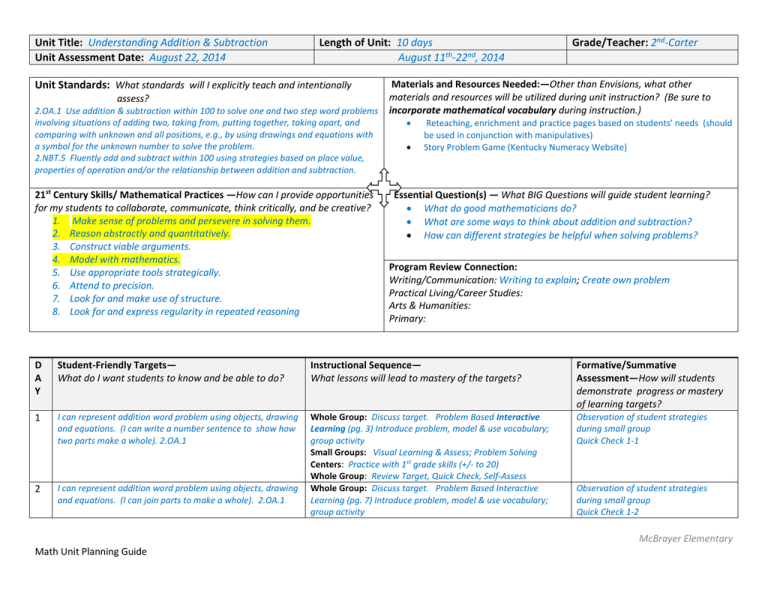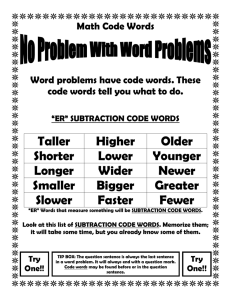Unit Title: Length of Unit: Grade/Teacher:
advertisement

Unit Title: Understanding Addition & Subtraction Unit Assessment Date: August 22, 2014 Length of Unit: 10 days August 11th-22nd, 2014 Unit Standards: What standards will I explicitly teach and intentionally assess? 2.OA.1 Use addition & subtraction within 100 to solve one and two step word problems involving situations of adding two, taking from, putting together, taking apart, and comparing with unknown and all positions, e.g., by using drawings and equations with a symbol for the unknown number to solve the problem. 2.NBT.5 Fluently add and subtract within 100 using strategies based on place value, properties of operation and/or the relationship between addition and subtraction. 21st Century Skills/ Mathematical Practices —How can I provide opportunities for my students to collaborate, communicate, think critically, and be creative? 1. Make sense of problems and persevere in solving them. 2. Reason abstractly and quantitatively. 3. Construct viable arguments. 4. Model with mathematics. 5. Use appropriate tools strategically. 6. Attend to precision. 7. Look for and make use of structure. 8. Look for and express regularity in repeated reasoning Grade/Teacher: 2nd-Carter Materials and Resources Needed:—Other than Envisions, what other materials and resources will be utilized during unit instruction? (Be sure to incorporate mathematical vocabulary during instruction.) Reteaching, enrichment and practice pages based on students’ needs (should be used in conjunction with manipulatives) Story Problem Game (Kentucky Numeracy Website) Essential Question(s) — What BIG Questions will guide student learning? What do good mathematicians do? What are some ways to think about addition and subtraction? How can different strategies be helpful when solving problems? Program Review Connection: Writing/Communication: Writing to explain; Create own problem Practical Living/Career Studies: Arts & Humanities: Primary: D A Y Student-Friendly Targets— What do I want students to know and be able to do? Instructional Sequence— What lessons will lead to mastery of the targets? Formative/Summative Assessment—How will students demonstrate progress or mastery of learning targets? 1 I can represent addition word problem using objects, drawing and equations. (I can write a number sentence to show how two parts make a whole). 2.OA.1 Observation of student strategies during small group Quick Check 1-1 2 I can represent addition word problem using objects, drawing and equations. (I can join parts to make a whole). 2.OA.1 Whole Group: Discuss target. Problem Based Interactive Learning (pg. 3) Introduce problem, model & use vocabulary; group activity Small Groups: Visual Learning & Assess; Problem Solving Centers: Practice with 1st grade skills (+/- to 20) Whole Group: Review Target, Quick Check, Self-Assess Whole Group: Discuss target. Problem Based Interactive Learning (pg. 7) Introduce problem, model & use vocabulary; group activity Observation of student strategies during small group Quick Check 1-2 McBrayer Elementary Math Unit Planning Guide 3 I can represent subtraction word problems using objects, drawings, and equations to find the missing part of a whole (I can write subtraction sentences to show the whole and the parts). 2.OA.1 4 I can represent subtraction word problems using objects, drawings, and equations to find the missing part of a whole (I can write subtraction sentences to solve problems about separating one part from the whole) 2.OA.1 5 I can represent addition word problem using objects, drawing and equations. (I can write a number sentence to show how two parts make a whole). 2.OA.1 I can represent subtraction word problems using objects, drawings, and equations to find the missing part of a whole (I can write subtraction sentences to solve problems about separating one part from the whole) 2.OA.1 I can represent subtraction word problems using objects, drawings, and equations to find the missing part of a whole (I can write subtraction sentences to solve problems about comparing numbers) 2.OA.1 6 7 I can fluently add and subtract using strategies based on the relationship between addition and subtraction (2NBT.5) I can write addition and subtraction number sentences to show a whole and its parts (2.OA.1) 8 I can represent subtraction word problems using objects, drawings, and equations to find the missing part of a whole (I can use counters to decide whether to add or subtract to solve a story problem.) 2.OA.1 9 10 Small Groups: Visual Learning; Problem Solving Centers: Practice with 1st grade skills (+/- to 20) Whole Group: Discuss target. Problem Based Interactive Learning (pg. 11) Introduce problem, model & use vocabulary; group activity Small Groups: Visual Learning & Assess; Problem Solving Centers: Common Core Review 1-1 Whole Group: Review Target, Quick Check, Self-Assess Whole Group: Discuss target. Problem Based Interactive Learning (pg. 15) Introduce problem, model & use vocabulary; group activity Small Groups: Visual Learning & Assess; Problem Solving Centers: Common Core Review 1-2 Whole Group: Review Target, Quick Check, Self-Assess Whole Group: Review, Reteach, Extend, Assess Small Groups: Reteaching Groups Based on Quick Checks & Observation (Differentiated Instruction) Centers: Common Core Review 1-3 or 1-4 Whole Group: Discuss target. Connecting Addition & Subtraction (pg. 23) Introduce problem, model & use vocabulary; group activity Small Groups: Visual Learning; Problem Solving Centers: Common Core Review 1-5; Games with fact families Whole Group: Review Target, Quick Check, Self-Assess Whole Group: Discuss target. Stories About Comparing (pg. 19) Introduce problem, model & use vocabulary; group activity Small Groups: Visual Learning; Problem Solving Centers: Common Core Review 1-6; Games with fact families Whole Group: Review Target, Quick Check, Self-Assess Whole Group: Discuss target. Stories About Comparing (pg. 19) Introduce problem, model & use vocabulary; group activity Small Groups: Visual Learning; Problem Solving Centers: Common Core Review 1-7; Games with fact families Whole Group: Review Target, Quick Check, Self-Assess Review Games; Can do unit assessment in small groups Reteaching & Extensions Clear up Misconceptions Observation of student strategies during small group Quick Check 1-3 Observation of student strategies during small group Quick Check 1-4 Writing to Explain from Samples in Lessons 1-4 (PR- Writing) Observation of Student Strategies during small group Quick Check 1-5 Observation of Student Strategies during small group Quick Check 1-6 Observation of Student Strategies during small group Quick Check 1-7 Unit Assessment McBrayer Elementary Math Unit Planning Guide Learning Target Assessed Day 1 Day 2 Day 3 Day 4 Day 5 Day 6 Day 7 Summative/Common Assessment Overview Number of Multiple Choice Questions Number of Short Answer Questions Numbers of Extended Response (OR) 1 4 2 5 6 3 7 (See Below) Extended Response: Use Performance Task on student assessment Rubric: (see scoring rubric on page 34 of Teacher’s Edition) McBrayer Elementary Math Unit Planning Guide




